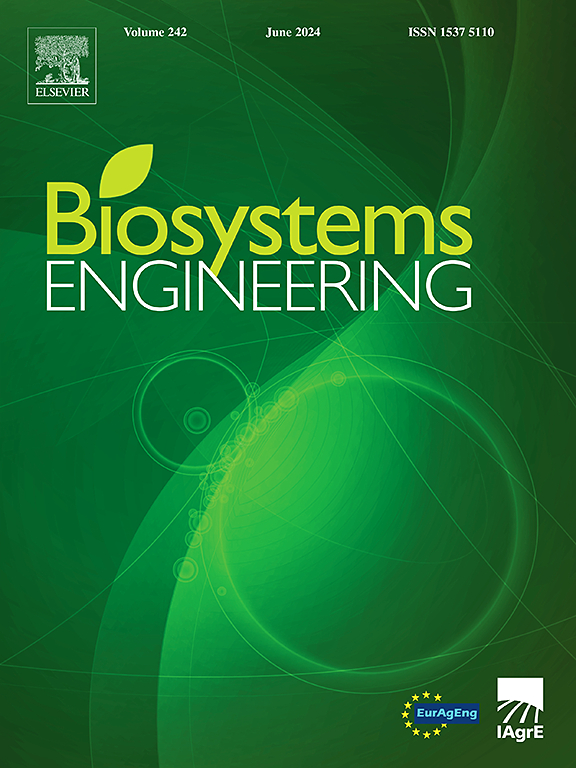Optimised random forest for predicting bed expansion and pressure drop in media filter backwashing
IF 5.3
1区 农林科学
Q1 AGRICULTURAL ENGINEERING
引用次数: 0
Abstract
In drip irrigation systems, media filters are frequently used to avoid emitter clogging, but periodic backwashing is required to restore media filtration capacity. Backwashing reverses the flow, fluidises the media, and expels trapped particles, being bed expansion (BE) and pressure drop (PD) the key parameters for assessing backwashing hydraulic performance. Available equations and models, however, often fail to reliably predict these parameters under diverse operational conditions. This study introduces a machine learning-based model utilising Random Forest Regression (RFR) and the Whale Optimisation Algorithm (WOA) to predict both BE and PD from a dataset of 705 backwashing runs carried out in the laboratory. For comparison, Lasso, Elastic-net, and Ridge regression models were also implemented with the WOA optimiser. The RFR model was tuned to enhance accuracy by identifying key operational inputs: filter medium type (three categories: silica sand 0.75–0.85 mm, microspheres 0.63–0.75 mm, and silica sand 0.63–0.75 mm), underdrain type (four categories), filter bed height (200 or 300 mm), and superficial velocity. Results showed the WOA/RFR model not only ranked input variable importance but also achieved superior predictive accuracy, with coefficients of determination of 0.9771 and 0.9957 for BE and PD, respectively. The WOA/RFR model consistently outperformed Lasso, Elastic-net, and Ridge models, but demonstrated robust alignment with experimental data. This study presents a novel and optimised approach for predicting bed expansion and pressure drop, enhancing the reliability of media filter backwashing performance assessments in irrigation systems.
预测介质过滤器反冲洗床层膨胀和压降的优化随机森林
在滴灌系统中,介质过滤器经常用于避免发射器堵塞,但需要定期反冲洗以恢复介质过滤能力。反洗使流体反向流动,使介质流化,并排出被捕获的颗粒,因此床层膨胀(BE)和压降(PD)是评估反洗水力性能的关键参数。然而,现有的方程和模型往往不能在不同的操作条件下可靠地预测这些参数。本研究介绍了一种基于机器学习的模型,利用随机森林回归(RFR)和鲸鱼优化算法(WOA)从实验室进行的705次反冲洗数据集预测BE和PD。为了比较,Lasso, Elastic-net和Ridge回归模型也使用WOA优化器实现。通过识别关键操作输入,对RFR模型进行了调整,以提高准确性:过滤介质类型(三种类型:0.75-0.85 mm的硅砂、0.63-0.75 mm的微球和0.63-0.75 mm的硅砂)、下漏类型(四种类型)、过滤床高度(200或300 mm)和浅层流速。结果表明,WOA/RFR模型不仅对输入变量重要性进行排序,而且对BE和PD的决定系数分别为0.9771和0.9957,预测精度较高。WOA/RFR模型始终优于Lasso、Elastic-net和Ridge模型,但与实验数据具有良好的一致性。本研究提出了一种新的优化方法来预测床层膨胀和压降,提高灌溉系统中介质过滤器反冲洗性能评估的可靠性。
本文章由计算机程序翻译,如有差异,请以英文原文为准。
求助全文
约1分钟内获得全文
求助全文
来源期刊

Biosystems Engineering
农林科学-农业工程
CiteScore
10.60
自引率
7.80%
发文量
239
审稿时长
53 days
期刊介绍:
Biosystems Engineering publishes research in engineering and the physical sciences that represent advances in understanding or modelling of the performance of biological systems for sustainable developments in land use and the environment, agriculture and amenity, bioproduction processes and the food chain. The subject matter of the journal reflects the wide range and interdisciplinary nature of research in engineering for biological systems.
 求助内容:
求助内容: 应助结果提醒方式:
应助结果提醒方式:


